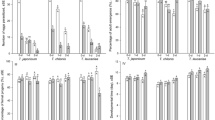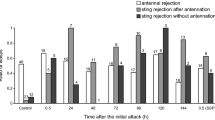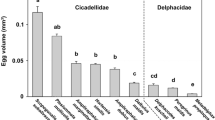Abstract
The cement used by females ofSupella longipala (F.) (Orthoptera∶Blattellidae) to bind their oothecae to substrates acts as a kairomone for host acceptance by the parasitoidComperia merceti. C. merceti discriminates parasitized from unparasitized oothecae and oviposts at reduced levels in the former. Low survival rates for parasitoids reared from oothecae receiving fewer than four ovipositions suggests that an “optimal density range” for resource utilization byC. merceti exists.
Similar content being viewed by others
References
Arthur, A.P. 1981. Host acceptance by parasitoids,in D.A. Nordlund, R.L. Jones, and W.J. Lewis (eds). Semiochemicals: Their Role in Pest Control, pp. 97–120. Wiley & Sons, New York.
Coler, R.R., van Driesche, R.G., andElkinton, J. 1984. Effect of an oothecal parasitoidComperia merceti (Compere) (Hymenoptera∶Encyrtidae) on a population of the brownbanded cockroach (Orthoptera∶Blattellidae).J. Environ. Entomol. 13:603–606.
Flanders, S.E. 1935. Host influence on the prolificacy and size ofTrichogramma.Pan-Pac. Entomol. 9(4):175–177.
Gordh, G. 1973. Biological investigations onComperia merceti (Compere), an encyrtid parasite of the cockroachSupella longipalpa (Serville).J. Entomol. (A) 47:115–123.
Lawson, F.A. 1954. Observations on the biology ofComperia merceti (Compere) (Hymenoptera: Encyrtidae).J. Kans. Entomol. Soc. 27(4):129–142.
LeBeck, L. 1983. University of California, Riverside, California. Personal communication.
Lenteren, J. C. Van 1981. Host discrimination by parasitoids,in D.A. Nordlund, R. L. Jones, and W.J. Lewis (eds.). Semiochemicals: Their Role in Pest Control, pp. 153–179. Wiley & Sons, New York.
Prokopy, R.J. 1981. Epideictic pheromones that influence spacing patterns of phytophagous insects,in D.A. Nordlund, R.L. Jones, and W.J. Lewis (eds). Semiochemicals: Their Role in Pest Control, pp. 181–213. Wiley & Sons, New York.
Silhacer, D.L., andMiller, G.L. 1972. Growth and development of the Indian meal moth,Plodia interpunctella (Lepidoptera: Phycitidae), under laboratory mass-rearing conditions.Ann. Entomol. Soc. Am. 65:1084–1087.
Vinson, S.B. 1975. Pages 14–48,in P. Price (ed.). Evolutionary Strategies of Parasitic Insects & Mites. New York: Plenum. 225 pp.
Author information
Authors and Affiliations
Rights and permissions
About this article
Cite this article
Van Driesche, R.G., Hulbert, C. Host acceptance and discrimination byComperia merceti (Compere) (Hymenoptera: Encyrtidae) and evidence for an optimal density range for resource utilization. J Chem Ecol 10, 1399–1409 (1984). https://doi.org/10.1007/BF00988121
Received:
Revised:
Issue Date:
DOI: https://doi.org/10.1007/BF00988121




